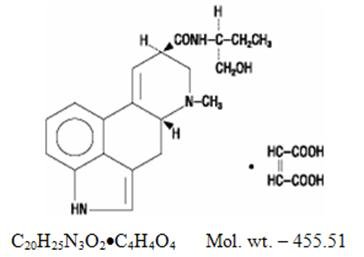Methylergonovine Maleate Injection
Dosage form: injection, solution
Drug class:Uterotonic agents
Medically reviewed by Drugs.com. Last updated on Nov 22, 2021.
On This Page
Methylergonovine Maleate Injection Description
Methylergonovine maleate is a semi-synthetic ergot alkaloid used for the prevention and control of postpartum hemorrhage.
Methylergonovine Maleate Injection is a clear, colorless, sterile solution available in 1 mL single dose vials, containing methylergonovine maleate 0.2 mg for intramuscular or intravenous injection.
Active Ingredient: methylergonovine maleate 0.2 mg.
Inactive Ingredients:maleic acid 0.10 mg; sodium chloride 7.0 mg; water for injection qs to 1 mL.
Chemically, methylergonovine maleate is designated as ergoline-8-carboxamide, 9,10-didehydro-N-[1-(hydroxymethyl)propyl]-6-methyl-,[8β(S)]-, (Z)-2-butenedioate (1:1) (salt).
Its structural formula is:

Methylergonovine Maleate Injection - Clinical Pharmacology
Methylergonovine maleate acts directly on the smooth muscle of the uterus and increases the tone, rate, and amplitude of rhythmic contractions. Thus, it induces a rapid and sustained tetanic uterotonic effect which shortens the third stage of labor and reduces blood loss. The onset of action after intravenous administration is immediate; after intramuscular administration, 2 to 5 minutes, and after oral administration, 5 to 10 minutes.
Pharmacokinetic studies following an intravenous injection have shown that methylergonovine is rapidly distributed from plasma to peripheral tissues within 2 to 3 minutes or less. The bioavailability after oral administration was reported to be about 60% with no accumulation after repeated doses. During delivery, with intramuscular injection, bioavailability increased to 78%. Ergot alkaloids are mostly eliminated by hepatic metabolism and excretion, and the decrease in bioavailability following oral administration is probably a result of first-pass metabolism in the liver.
Bioavailability studies conducted in fasting healthy female volunteers have shown that oral absorption of a...



